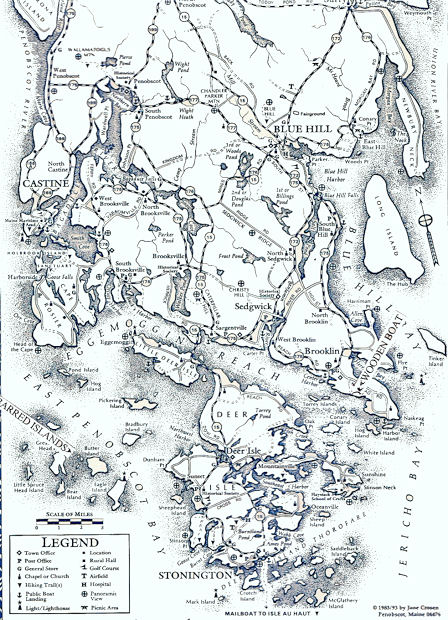| Danny Clears the Way for a Great
Maine Cruise by Dick Harrington Part II ... |
|||
|
At 73, I've become more cautious about
embarking alone upon a potentially difficult cruise. So it was a
comfort and pleasure to have my good friend, Dennis Figley, from
Ashland, Ohio, as my sailing companion during this week-long cruise on
Maine's mid-coast.
Past experience has shown early September to be an outstanding time to venture out on Maine's coastal waters. That it is also hurricane season obviously can be a concern. This year proved to be no exception. The weather following Hurricane Danny - then down-graded to a gale-force storm - turned out to be fantastic. From Sunday on, we enjoyed nothing but warm sunny weather - the best Maine had all summer - though on occasions the wind was light. The log up to now. After being held up a day by Danny, Dennis and I departed from Tenants Harbor on Sunday, August 30th. We sailed a northeasterly course up Muscle Ridge Channel, then tuned east, crossing Penobscot Bay to the White Islands. The following day, we made stops at Hurricane Island and Carvers Harbor before anchoring for the night at Merchant Island, in Merchants Row. By Tuesday the wind had become light and it was a struggle just to complete the 10 NM to Burnt Coat Harbor, on Swans Island. 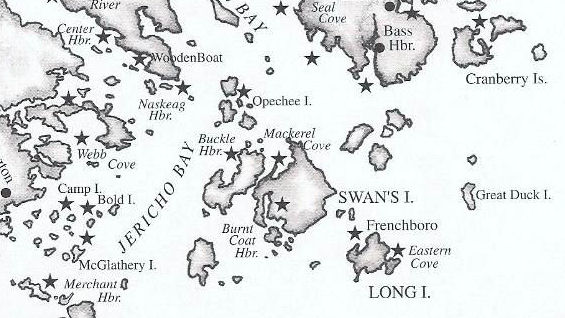 Wednesday,
Sept. 2, 2009. At Burnt Coat harbor we awoke to another
gorgeous morning after dining on delicious - just off the boat -
lobsters the evening before. The sky was clear and the sun warm;
but like the previous day, there was hardly any wind. Drifting
past the stately schooner, Heritage,
we bid farewell to this beautiful harbor. Getting through the narrow
east entrance once more called for using the oars. However, even
after we arrived outside, the wind remained elusive, not appearing
until we had rowed a few hundred meters off shore.
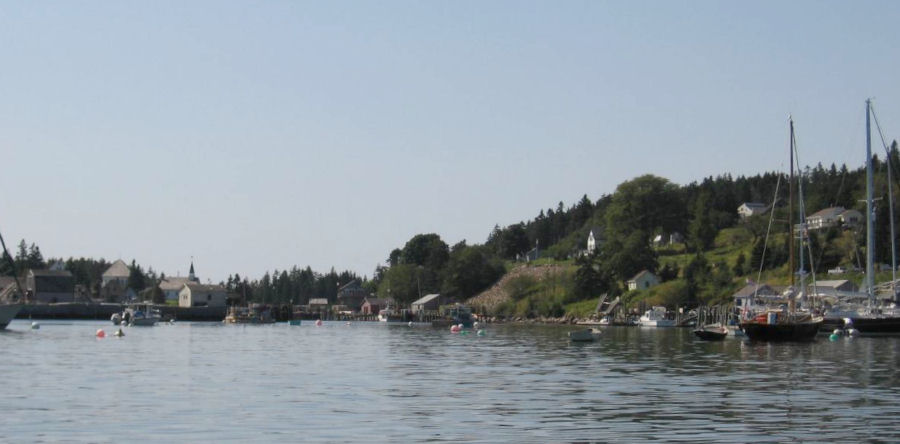 Arriving
in Frenchboro. Lunt Harbor imparts a sense of having stepped back in
time.
I gave Dennis the compass
heading for Frenchboro, on Long Island, and he steered
accordingly. This was the furthest east we would go - having
decided that after Frenchboro, we needed to begin swinging back.
With the breeze improving, the crossing of less than 3 NM didn't take
long. Frenchboro is extremely interesting. During my first Maine
cruises, I had been reluctant to venture so far off shore. Now,
however, I try to stop there when possible. And it is so unique
that I really wanted Dennis to see it.
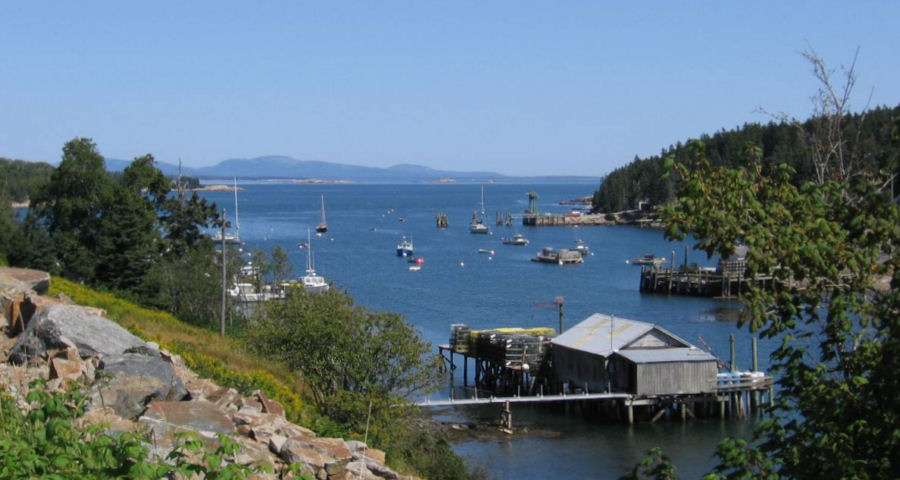 Frenchboro's outer harbor - looking north. In the distance are the high peaks of Mount Desert Is. Such fair weather and crystal clear visibility are rare.
By now I'm sure Dennis had me
figured out. I was content to let him have the helm for long periods on
the water, but when entering a harbor, I would be chomping at the bit
to take over. The more congested things were, the better I liked it. Blue Mist is a fine-looking 'woody'
and my baby, so I don't think he minded letting me be the one to chance
a mishap - at least that is my excuse!
As is the case with many Maine harbors, Frenchboro's town landing is situated at the very far end of the inner harbor. Getting there entailed a fair amount of tacking, in a shifty wind, picking our way through a pack of boats on moorings, and vacant moorings, as well as avoiding several large outlying rocks. Coming into the floating dock, Blue Mist was moving a bit faster than I wanted, forcing Dennis to cushion our impact. My ego would have liked a second chance. Still, I thought we had done pretty well. Unbeknownst to us, we were
being watched! "I saw you coming in and had to hurry down to meet you.
What a beautiful boat!" Involved in the task neatening up the cockpit,
I was caught by surprise. Dennis was, too. Looking up, I
saw the man who had spoken standing on the dock above me. "What I
need is a boat like this one," the man lamented, adding, "I own a Cape Dory that hasn't been in the
water for two years - it's too much work, and my wife won't help
me." He was anxious to know about our adventures, obviously green
with envy. This was our pleasant welcome to Frenchboro.
The time was approaching noon and I remembered that there was a small fish-shack eating place located on Lunt Wharf. Hungry, we headed on foot for the far side of the harbor to see about some lunch. Along the way, we happened across an artist working at his easel at the side of the harbor road. Pausing for a few moments, we admired his painting. With the lobstermen mostly out working, we found few people moving about. As Taft says, Frenchboro is a quiet, peaceful town far removed from the fast pace of the rest of the world. I thought that things looked more prosperous and less run-down than the first time I was there with Tom Graefe, a few years back. A very dilapidated building that previously looked as if it were about to fall into the harbor was gone. Evidently lobster fishing is proving to be a successful way of making a living. Also, I suspect there is a small contingent of summer residents, such as the fellow we met on the dock, whom help keep the economy going. It would seem that the one-time worry that Frenchboro would decline into extinction is probably history. We were lucky. The lunch
kitchen, a shack on a wharf with some outside picnic tables, wouldn't
close for the season until tomorrow. I ordered a delicious fish
chowder, while Dennis devoured a big sausage sandwich. Before
leaving, we took advantage of an outdoor sink to wash away some of the
salty encrustation from our faces.
 Having stretched our legs and
seen some of the town, albeit briefly, we felt it was time to return to
Blue Mist. The
southwesterly was looking good and we had lots of sea miles to cover.
Our next anchorage would be Buckle Harbor, located on the northwest
side of Swan's Island. It was by then afternoon and the distance
close to 12 NM. However, we would have a reach most of the way
along the eastern side of Swan's Island with a 10 to 12 knot
breeze. So I wasn't too worried.
Though open water sailing can
be enjoyable, it is not nearly as much fun as threading through
picturesque island passages such as Merchant Row. Rounding North Point,
the northern tip of the Swan's Island, put us under the big island's
lee, stifling our wind. Now, Dennis decided it was my turn to have the
tiller - ugh! Regardless, the doldrums lasted but briefly before the
breeze returned - this time coming from around the west side of the
island. Now on our nose and freshening - it was being funneled between
the islands of Casco Passage ahead of us - we were forced to beat
through the narrows. So things got more interesting!
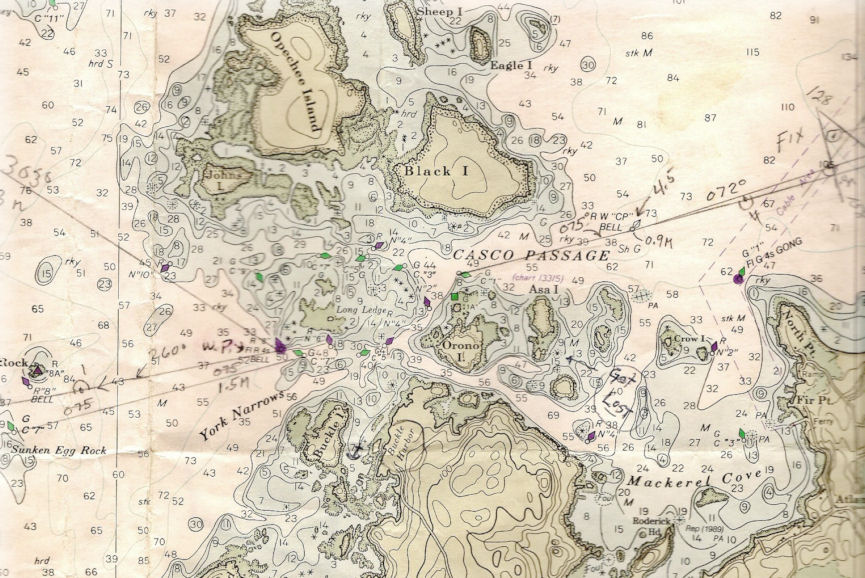 Casco Passage can be confusing
and tricky, and York Narrows immediately to the west even more
so. In anything but calm weather, it could be dangerous taking a
yacht through under sail alone. The channel is narrow and twisting,
with many sharp turns; and reefs lying close by on all sides. Most big
boats motor through. On the other hand, with a centerboard dinghy, it
is easy enough, provided one doesn't get off track.
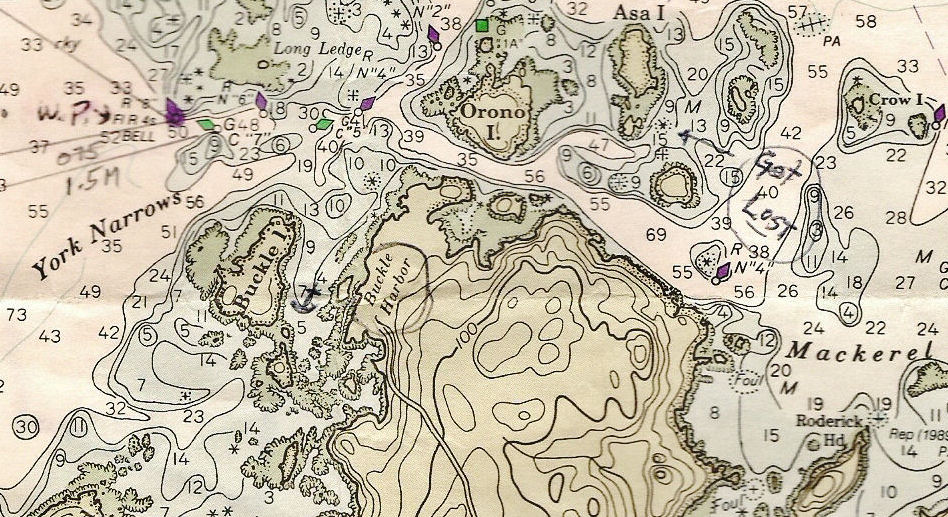 Having been through this
passage at least half a dozen times, I should have known the way.
Except that somehow, in the process of making crisscross tacks, we
missed a key channel marker, ending up buried within the group of small
islands to the south. Having foolishly run up a blind bay that turned
into a rock garden, I was hopelessly confused and forced to resort to
the GPS for a fix - the first of two such blunders. Was this is a
sign of aging? I'm afraid so!
Buckle Harbor is an attractive, long, narrow bay surrounded by low headlands. Laying east of Buckle Island, it is quiet and peaceful with no hint of human habitation. When we arrived shortly after 4:00 PM, it was low tide. Already anchored in deeper water were a two cruising sailboats which would soon be joined by a couple of others. Back when first discussing the
cruise with Dennis, I promised we would eat Maine mussels. Now,
it occurred to me, I might be able follow through on that
promise. So instead of anchoring, we continued - way back to the
far end of the bay, passing over nasty ledges and boulders - in search
of dinner. Sure enough, in water barely deep enough to keep from
scraping Blue Mist's undersides, thousands of mussels covered the
bottom. (see About Maine
Mussels below)
Donning shell-proof wading
shoes, we had the bucket two-thirds full in twenty minutes - which was
way more mussels than we could possibly eat. Returning to deeper water,
we anchored in a picturesque spot away from the crowd and close to the
spruce-cloaked shores of Buckle Island. Thinking about what a
nice spot we had, I couldn't help musing - did those on the big yachts
- anchored way out - envy us and our ability to go almost anywhere, or
were they mired in the luxury of big-boat living, just thinking we were
crazy? I will never know.
While preparing a sumptuous
mussel dinner, we became intrigued by the peculiar actions of a guy in
a small rubber dinghy from one of the yachts. Motoring toward us, the
man would every so often abruptly kill the engine to do something. This
behavior was repeated numerous times as the man approached. Intrigued,
we couldn't figure out what the man was doing. Finally, he was near
enough so that I could speak to him. "Having a motor problem?" I asked,
good naturedly. "Oh, no!" he replied. "I'm just checking the
depth. I see that I could have come in a lot further in, but I was
afraid to try." Yes - it dawned upon us - that was a lead-line he held
in his hand. Meanwhile, instead of dying with the sunset, the
south wind continued to whistle down the shore of the island until late
into the night. It was a chilly evening, making us glad for the
protection of the boom tent.
Thursday,
Sept. 3 The tide was up, which was not the best
time to be trying to get
ashore. Blue Mist lay
practically within a stone's throw of Buckle Island's spruce
thickets of . But the steep, smooth grey granite along
the water's edge looked unapproachable. "I don't see any ready place
we can land," I moaned to Dennis. But Dennis suggested we check out a
slight indentation a short way down, and it turned out to be a perfect
spot to nudge into. Dropping the anchor off of the bow a few meters
out, we backed in until it was shallow enough to wade ashore. Taking a
long stern line with me (approximately 50 feet), I let Blue Mist drift
out a little way before tying it off to a rock. "This should be good
for twenty minutes," I told Dennis. "Should we decide to stay longer,
it will be necessary to return and adjust the lines." In these
waters I would rarely think of beaching. There are too many rocks and
the tide changes very quickly.
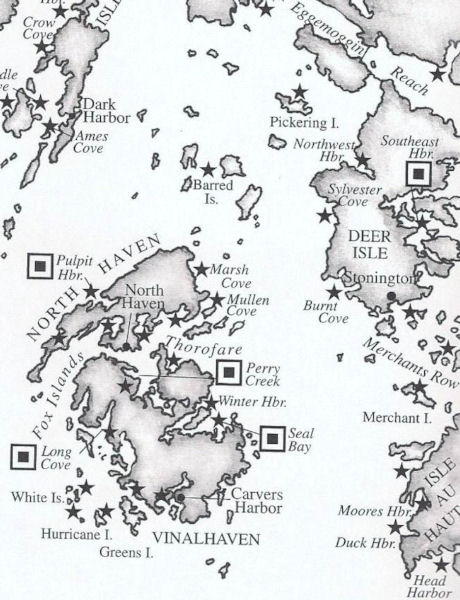 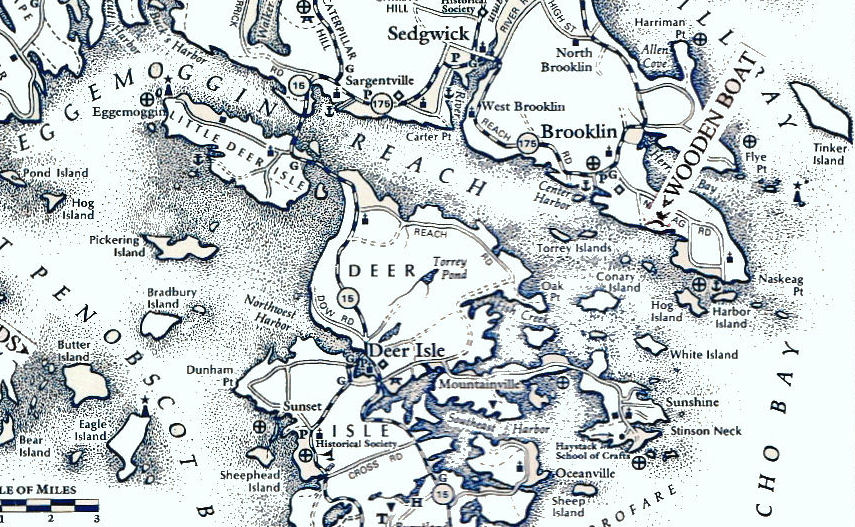 Another perfect day, and we
were up early as usual. Over breakfast, we discussed plans for the next
phase of our adventures. I made a couple of suggestions: head west,
toward Merchant Row, or north to Eggemoggin Reach. We had seen only a
small part of Merchant Row so far. On Eggemoggin Reach we could,
on the other hand, stop at the renowned Wooden Boat School in Brooklin.
Following that, we could continue west to East Penobscot Bay and the
Barred Islands. It was decided that we should head north. Dennis wanted
to see Wooden Boat.
With a weak southwesterly wind, Dennis put Blue Mist on northwest heading. The first leg to Wooden Boat was about 6 NM. However, it turned out that the second leg from Wooden Boat to the Barred Islands, was nearly 16 NM. An oversight - I didn't have the chart of the western part of the Reach with me. Consequently, there would be a brief spell where we would be sailing by the seat of our pants. This was not a serious problem, but I hadn't realized the Barreds were quite so far. In the end, not knowing this was probably a good thing. An hour or so later, when we were still a couple of miles from Wooden Boat, the wind petered out. Then, after rowing for a while, I realized that we were again lost. Exactly where were we? Examining the chart, I still wasn't sure. Dennis pointed out that the channel was too narrow to be the Reach - plus, there weren't any buoys. How could we have gotten off track on such calm, clear day? This was Dennis' first time here; he had an excuse, but I didn't. Facing backwards, rowing, can do that, I guess. Again the GPS solved the mystery. But I was surprised to discover how far off course we had strayed - wandering to the wrong side of an island, and then mistaking it for another. Thankfully, our frustration was soon eased when the breeze decided to return. Half an hour later we had arrived at the school's landing. Boat building was in full swing
at the Wooden Boat School,
with maybe half a dozen small boats of various types at different
stages of completion. The shop doors were wide open, and we watched
with interest, the energetic activities of a class of maybe 10 or 12
amateur boat builders. The many smiling faces made it clear that they
were having the time of their lives.
The southwesterly had piped up - we didn't want to tarry long. Still, before departing, we had sufficient time to don swim trunks and take advantage of the outdoor shower next to the boat house, our first since heading out. Shampooing my matted hair felt wonderful. Headed westerly on Eggemoggin Reach, we were making excellent time. Except, now I began to realize how far we still had to go. I had forgotten how long the Reach was. Far ahead, we could make out the high suspension bridge crossing over from the mainland to Little Deer Isle. When we reached the bridge, we would be three quarters of the way through the Reach, so the bridge became a central focal point, one that ever so slowly it grew bigger in size. Meanwhile, we were seeing more
sailboats than previously. There were small boats out for a day-sail,
as well as an occasional passing yacht. Some, unique in hull design or
rig, attracted our interest. The day-sailors were obviously local
boats, while most of the others were cruising like us, taking advantage
of this fabulous short-cut between Jericho Bay to the east and East
Penobscot Bay to the west.
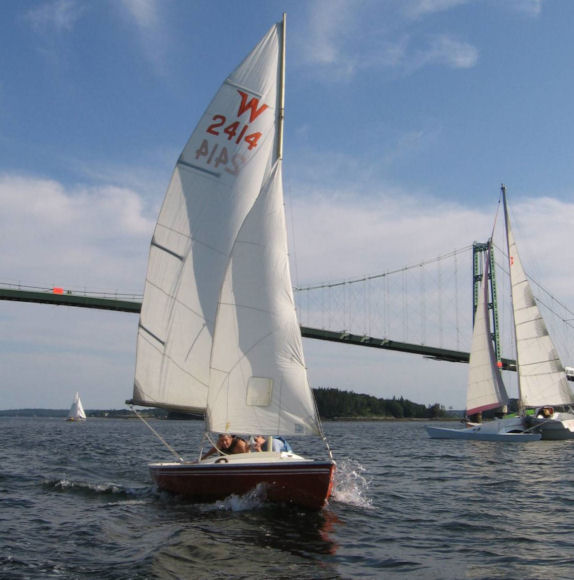 Passing beneath the suspension bridge over Eggemoggin Reach with Chris and Jennifer. When we were maybe half a mile
from the bridge, Dennis suddenly exclaimed, "Dick, that looks like a
Wayfarer!" To our left, in close to shore, a small sailboat was setting
out. "Nah, I don't think so," I replied, unable to imagine the
likelihood. From that distance the boat looked too tiny. But
Dennis was insistent. "I'm sure it's a Wayfarer", he maintained.
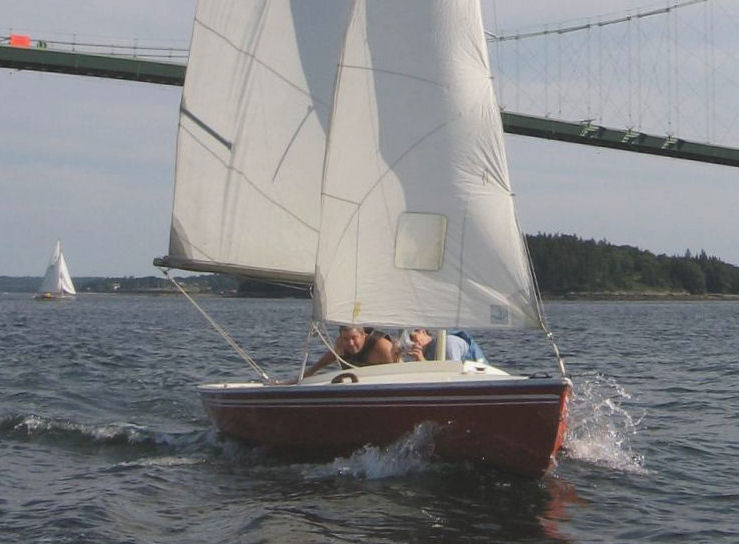 That was how we met North
Carolinians - Chris Marthinson and his wife, Jennifer Drolet - sailing
W2414, Juliet, on a sunny
September afternoon in a nice breeze on Eggemoggin Reach. Spying us
with equal disbelief, they quickly made a beeline for Blue Mist. For the better part of
the ensuing hour, the two boats remained engaged in a running
conversation; some times shouting over the wind, while at other times
resorting to the VHF.
We learned that W2414 is
permanently ensconced on Deer Isle, where Chris and Jennifer found her.
Jennifer explains that the couple have a sweetheart deal with a woman
living there, one that has them making the trip to and fro from North
Carolina to deliver the woman's car and dog - all expenses paid - each
Spring and Fall! On each trip they spend a week enjoying Maine and
sailing their Wayfarer Juliet.
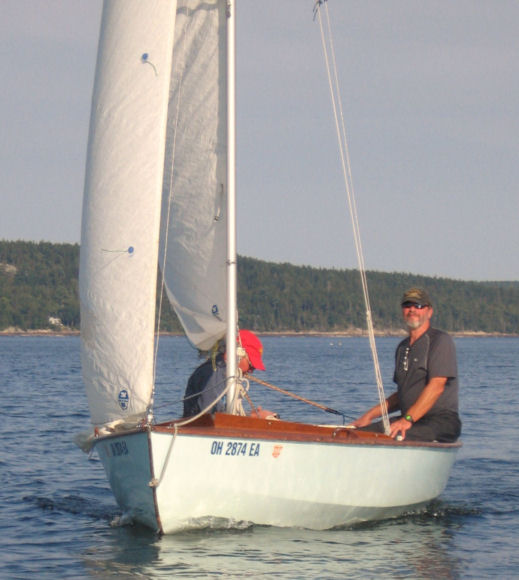 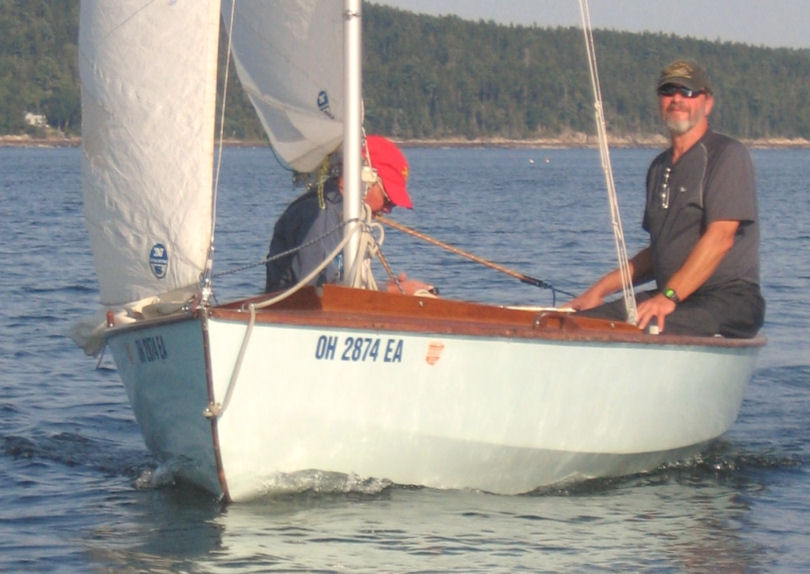 Dennis (r) at the helm on the Reach By the time the two Wayfarers
had reached Pumpkin Island, the site of the old lighthouse marking the
west entrance to the Reach, the sun was low. It was time for
Chris and Jennifer to turn back and we waved good-bye. Before
separating, we agreed to get in touch. But, attempting to take notes
while at the same time manning the radio, I garbled some of their
message. As a result I wasn't able to contact them until recently when
they e-mailed me.
Having gone full circle, we were now headed south and beating to windward. The realization that it was getting late set in. We would be hard pressed to reach the Barred Islands before nightfall. This small group of islands lay hidden behind a distant green shroud posed by the bigger islands between us and them. Tapping the GPS waypoint 'go-to' button revealed we still had six long NM to go. 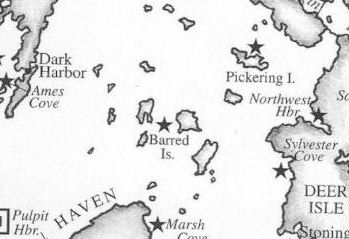 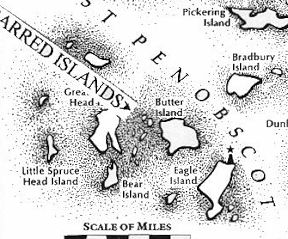 Consisting of six low islands
closely linked by a web of bars, the Barreds offer a well protected
anchorage. They are intriguing and peaceful, but what I enjoy most is
the trickery needed for sneaking in through the bars. The islands lie
between Butter Island and Great Spruce Head Island. But before
that, are Pickering Island and Bradbury Island. All are high; and from
a distance the differences are subtle. Thus, with twilight
approaching I felt a definite need for the GPS.
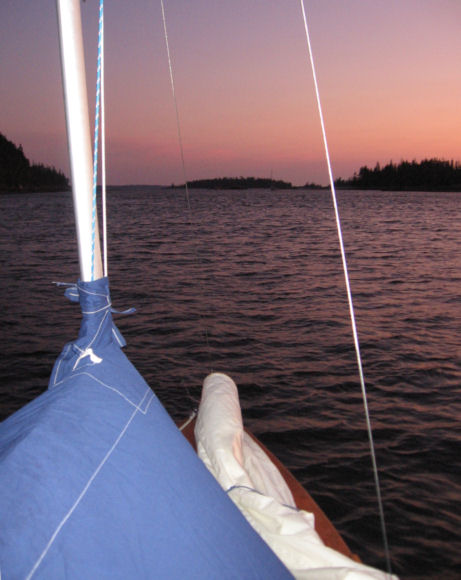 Nightfall in the Barreds With the sun already down - but
with enough light remaining from a deepening red sky to find our way -
we, at last, gently scraped over a gravel bar and into our anchorage.
Having covered around 22 NM since departing Buckler Harbor, we were
tired. Dinner would be late that evening!
Friday, Sept. 4 We had anchored at the north end of the harbor, which is too shallow for anything other than a dinghy. This meant we had the place to ourselves. The cool night breeze again held late into the evening, but dissipated before dawn. By morning, the tide was down and there were but a couple of feet of water between Blue Mist's keel and the bottom. Every detail of the shells below was visible. Unfortunately our enthusiasm was dampened when we rowed ashore and encountered No Trespassing signs. However, I thought that Dennis had a good take, "It's probably the fault of others more than the owners." he commented. We had little choice but to make the trip as hurried as we could. With little wind, we headed south for North Haven Island, a place of considerable wealth. 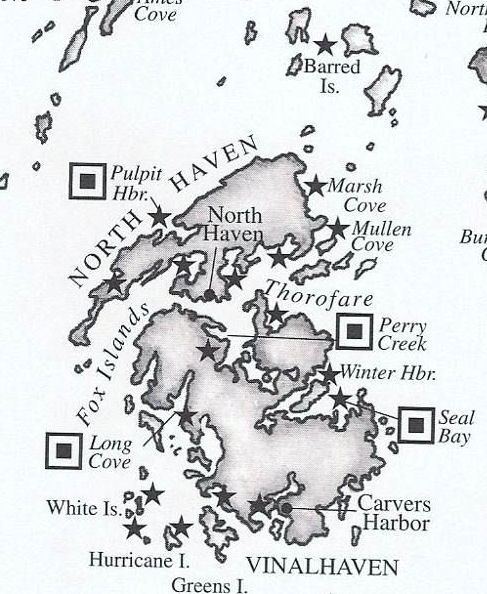 This would turn out to be one
of our slowest days. Moving at a painful snail's pace, we worked our
way down the north side of North Haven - alternating between sailing
and rowing. Saving us from complete boredom was the beautiful scenery,
some acrobatic antics of an energetic gull catching small fish, and
chance encounters with two magnificent turn-of-the-century yachts. By
noon we had covered less than 6 NM and were nearing Pulpit Harbor,
where we decided to drop in for a look. As always seems to happen, once
we were inside the harbor, a bit of wind decided show up - but we went
in anyway.
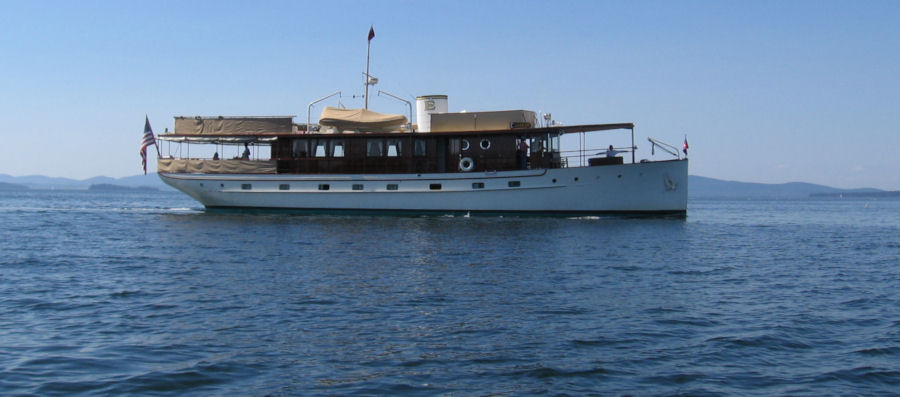 North Haven Island exhibits its yachting tradition as well as considerable wealth. Pulpit Harbor is attractive and
a popular stop for windjammers. Though crowded - there are quite a few
boats on moorings - it is worth seeing. However, there's lots of money
on North Haven; and it has been my experience that it is not all that
accommodating to a dinghy cruiser. Following an initial false landing
at a private dock, we located the public landing. It was a nice
spacious float, but there weren't any toilets; and signs told us to
keep our trash. Feeling a chill in the air, we didn't stay long.
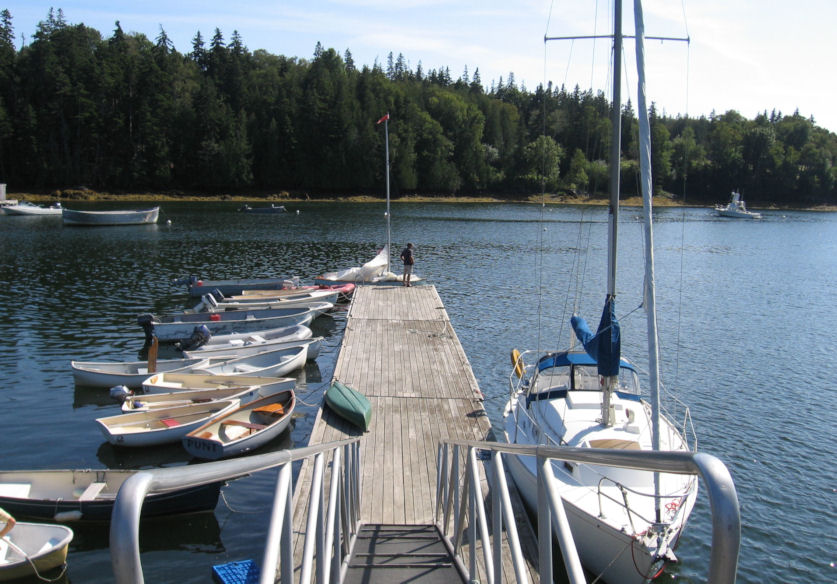 The public landing at Pulpit Harbor 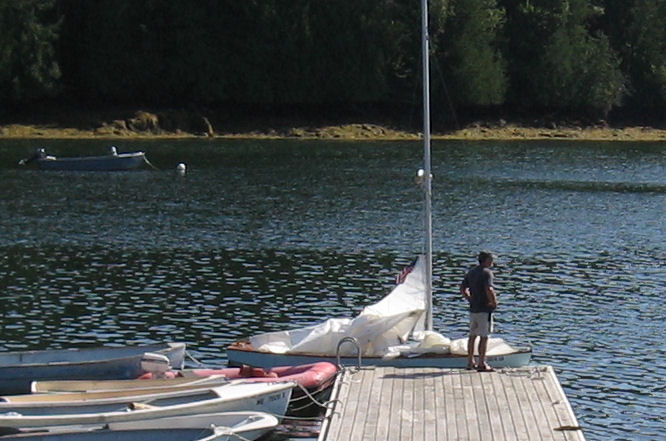 Earlier that morning I held out
had entertained hopes of running down the side of North Haven and then
turning east to traverse the Fox Islands Thorofare. The Thorofare,
which runs between North Haven and Vinalhaven Islands, had made for an
enjoyable passage at times in the past. Except that once we were back
outside Pulpit Harbor and headed for Stand-in-Point - that long jutting
finger of land that needs to be rounded in order to enter the Thorofare
- the wind showed little improvement. It became clear that my
earlier hopes were dashed.
"Okay, let's give it up and
head for Long Cove on Vinalhaven. If we can get across the bar at
the far end, it is pretty and secluded," I proposed to Dennis.
But as time dragged on and the sun got lower, the wind became
weaker. Eventually, we were on the oars again. It was
getting to be late afternoon and we still faced the prospect of a 1-1/2
to 2 mile stint to get through a couple windless, narrow
passages. That was too much. Resorting to plan 'C', we
opted for the much nearer Crockett Cove, not the ideal location, being
more open and dotted with houses, but we were nevertheless relieved to
be anchored. I was more than ready for a bottle of beer, some
dinner, and a glass of wine. The drudgery of a day of painfully
slow sailing had been wearing; we had covered only 13NM.
Our goal was to be back for haul-out at Tenants Harbor before noon Sunday. So we hoped to re-cross Penobscot Bay on Saturday and to position ourselves for a short sail on the final morning. The weather forecast was excellent. A weak cold front was projected to pass through the region during the day, but there would be few clouds and little noticeable effect. Some time during the evening, the wind would shift to the north at 20 knots. There was nothing to trigger any alarm. Saturday, Sept. 5 Things looked vastly better in the morning. An inspiring southerly breeze kicked up small whitecaps out on the Thorofare, motivating us to get moving. Crockett Cove was much too built up for us to go ashore. "Let's run up the Thorofare to the town of North Haven for our morning break," I suggested. I recalled that there was a general store with pay toilets and a shower. 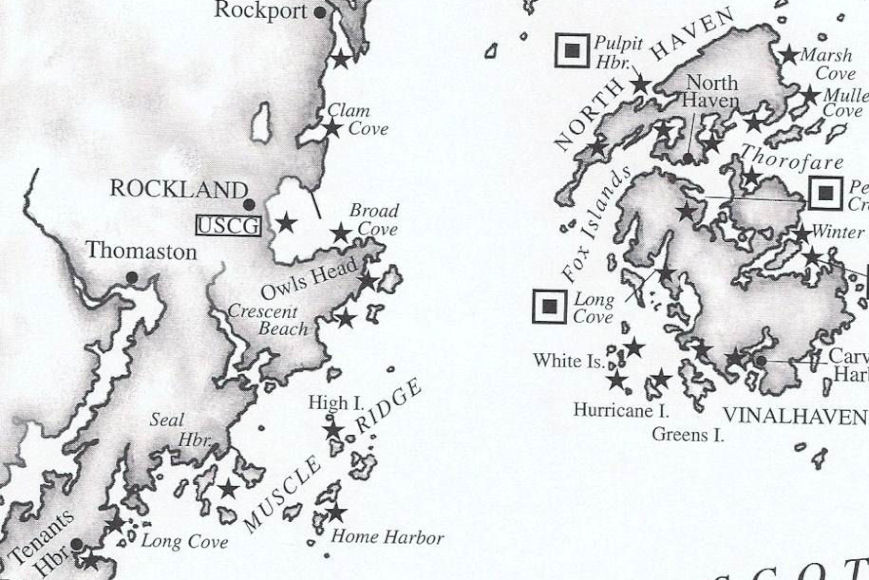 The run into North Haven was
fast and fun, until ... "Ease! Dennis! Ease!" I yelped. Caught by
surprise, I couldn't help myself. An unexpected gust had rolled Blue Mist's lee rail a little too
low for my comfort. Dennis, who seemed to be enjoying the excitement,
probably wasn't pleased with me. Landing at the dinghy sailing club
where I had been before, we had our pick of spots. The well appointed
facility is large, boasting a number of floats. The club supports a
strong youth sailing program in the summer, I recall. Now, however, it
being late in the season, there were only a handful of boats and people
on the docks. We were welcome to tie up.
The picturesque village hadn't changed appreciably from my last visit, which was maybe six or seven years ago. Except, it seemed touristier; and to our disappointment, the quaint old general store was no longer there. All that remained was a decrepit, falling-down building on the old coal dock, long-ago abandoned. After some searching, we happened upon nice bathrooms at the ferry terminal ticket office. The modern-looking terminal appeared to be new and was bustling with passengers. I'm not sure what the woman selling tickets thought about us two scruffy-looking salts with our week-old beards. The fancy breakfast places were tempting, but we decided it was time for us to move on. By the time we reached the fairway buoy marking the mid-channel shipping lane in Penobscot Bay, the wind was turning fickle again. Stuck in this no-mans land, we watched a big sea tug pushing a barge steam rapidly up from the south. First appearing as a dark smudge on the horizon, it was closing fast. Though we were not worried, he had us guessing which side of us he would pass. But when he made his turn he was still half a mile away - no harm done. 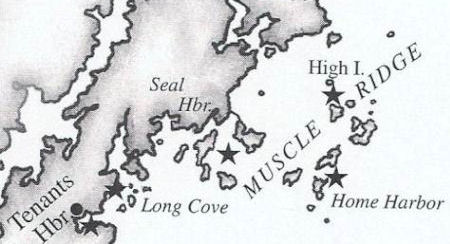 A while longer and Dennis was
wondering, "Think we can make Tenants Harbor? We'll be able to
get an early start in the morning," he commented. To be sure, he was
thinking about our renewed slow progress. Nevertheless, I remained
stubborn. "No! Don't worry; the sail in the morning will be
quick," I retorted. High Island was the terrific anchorage at the north
end of Muscle Ridge that we had by-passed our first day out. It had
long been a favorite stop of mine and I was looking forward to spending
our last night there.
"Around here somewhere, there's this really gorgeous sandy beach. Tom Graefe and I landed there the last time we were here." I was attempting to explain my reason for searching around in what amounted to a labyrinth of shallow back-water lagoons. Coming in, we had taken a short-cut, threading between some ledges behind the islands. The breeze had picked up; enough so that gliding over the quiet stretches of flat water was pleasant and fun. On the other hand, the tide was almost full-down and the shell-strewn bottom, and occasional boulder, were getting too close. As we turned to the outside, in the direction of where several boats were already at anchor, the big sandbar suddenly jumped out at us. "Harrah, there's the spot!" With grins on our faces, we dropped the big anchor in two feet of water and waded ashore. There aren't many beaches like this one in this part of Maine! It was still early and we had time to explore. At an earlier time, Tom Graefe and I had made a landing on High Island. It is an island that has been quarried. Possibly a century old, the large stone quay for loading ships still remains. In our rambling about, we had stumbled across the old quarry, hidden behind tall spruce trees. It had been like discovering some ancient ruins. The waters of the quarry were so inviting that we went back to Blue Mist to fetch our bathing trunks. 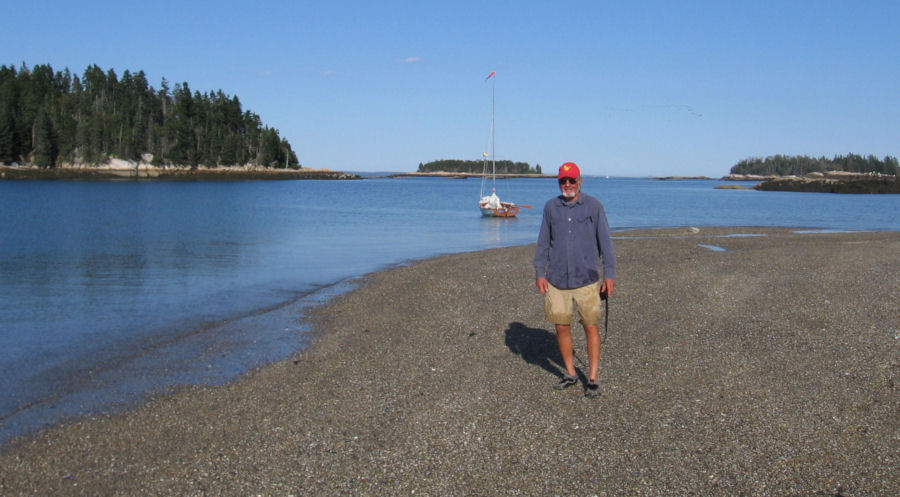 On the beach at Birch Island, the author, Dick Harrington, takes in the beauty and ambiance of this wonderful harbor lying between Birch and High Islands. - click here for larger image 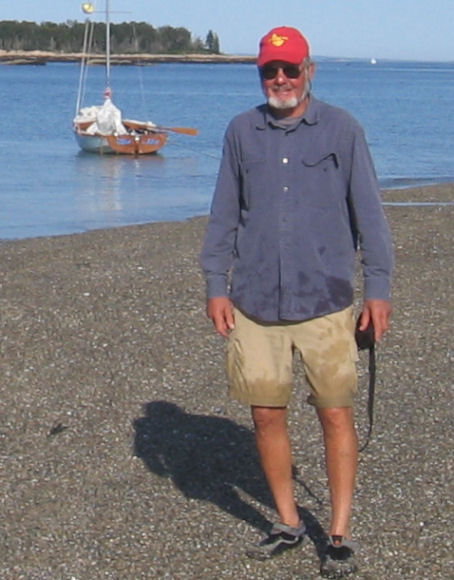 Dick Harrington with his beloved Blue Mist in the background On Birch Island beach we had
company from one of the other boats - a woman in a beach chair with a
sun umbrella, soaking up some sun while reading. Splitting and going in
a different direction, Dennis found a sign that said Welcome to Birch Island - no fires please.
How great of the owners to be so open and generous! Meanwhile, I
snapped more pictures - they would remind me at a later time what a
remarkable place this was.
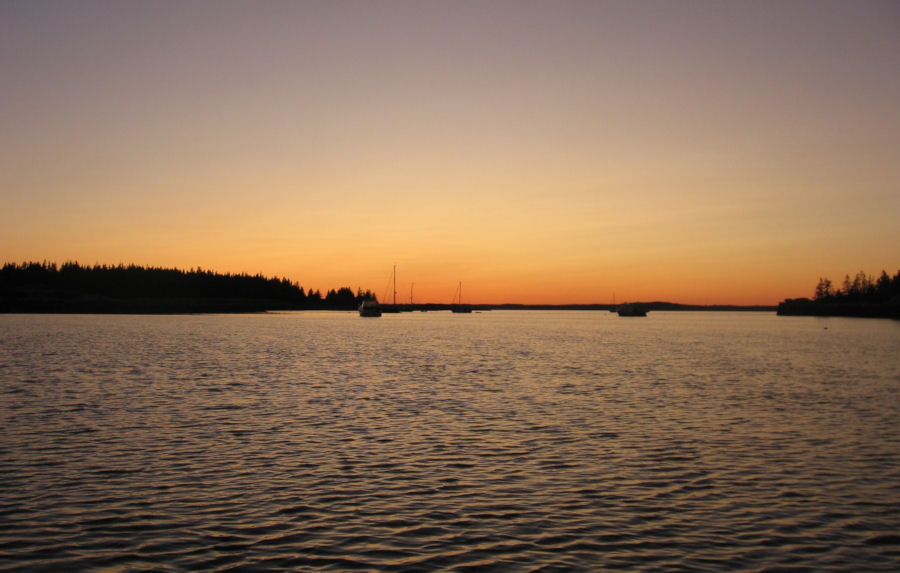 Night falls at High Island. With us are half a dozen cruising boats anchored in deeper water. It was low tide. In the rocky,
shell-laden lagoon behind the sand beach were mussels. "Hey, Dennis,
feel like mussels for dinner again?" I called out. His answer was
affirmative! So back to the boat I went to fetch the bucket.
"We're sure bringing lots of food back home with us," was Dennis'
comment following dinner. Unfortunately, we had, to our chagrin,
completely run out of both beer and wine. (Later, when emptying
out the boat, I was really 'ticked' when I discovered a bottle of wine
that had gotten mislaid.)
Nightfall arrived blissfully,
with a marvelous sunset. We had enjoyed a decent day of sailing, having
covered about 15NM. Anticipating a restful night's sleep, we turned in,
dreaming about making an early departure in the morning. What a
surprise we were in for!
From a sound sleep in the middle of the night, I was abruptly jolted wide awake. A few moments passed, and again Blue Mist made a hard, bone jarring lurch, as a wave loudly slapped her side next to my ear. The awkward rolling motion of the boat was uncomfortable. Forward beneath the foredeck, something was banging against the hull. It must be the horn dangling from its pendant, I concluded. My brain was racing, trying to comprehend what was happening. Dennis was quiet - there was no snoring. Was he awake too? Blue Mist continued her painfully wrenching roll. I felt bad for my boat; and the banging was bugging me. There was no chance of going back to sleep. The wind had picked up. I could hear the surf pounding the shore on the other side of the island. Ah, yes, it was the north wind that had been predicted! Slipping the edge of the boom tent over the corner of the transom, I could see waves - but nothing alarming. But from the direction of the other boats I saw a spotlight and heard loud voices. Someone over there seemed to be having a problem of some kind. This added to my anxiety. Unzipping my sleeping bag, I
climbed forward, over the thwart and piles of gear, while trying not to
slip and land upon Dennis. Secured, the horn stopped its banging. As
far as I could tell by peering out the front windows, it didn't appear
that Blue Mist was swinging
excessively on the anchor rode. Nevertheless, it was clear that she was
coming broadside to the waves; with an occasional wave nasty enough to
knock her on her beam's end. I surmised that there might be a wash
coming from around the island.
Thinking of Margaret Dye's writing in her book, Dinghy Cruising, I recalled an episode where she and Frank endured a similar unpleasant experience. A strong tidal current had held Wanderer askew to the waves. It had been very uncomfortable. Frank had contrived some form of a bridle, a line attached to the anchor rode and running aft, to force Wanderer to point into the waves. Frank was a genius when it came to things like that. Convinced we might be in a comparable situation, with the tide and wind at odds and trying to push us in different directions, I decided to experiment by putting the board down. Remarkably, that made an improvement - though I don't know exactly why. Soon, however, the board started to emit an unhappy creaking sound. Jamming a thin rubber, protective pad I keep in the anchor bucket, between of the top of the slot and the board fixed that problem. Feeling better, but mentally worn out, I fell back to sleep. In the morning Dennis revealed
he had indeed been awake throughout the ordeal. He was as mystified as
I was. What, if anything, occurred on the other boat that night, I
don't know - possibly it was an anchor dragging. Normally, sleeping on Blue Mist is as peaceful and gentle
as rocking in a cradle. I've been though some severe storms that
created rough, unpleasant conditions, but nothing quite like that. It's
another example of the tricks that wind and tide can play upon would-be
dinghy cruisers, I guess.
Sunday, Sept. 6 It was pleasant, cooler with clouds and sun. We quickly forgot about that brief, stressful period during the night. The cruise was ending, but certainly not disappointingly so. Outside the anchorage, an invigorating north wind - though no longer blowing 20 knots - had whitecaps rolling down Muscle Ridge channel. The trip into Tenants Harbor would be fast and a blast. Breakfast could wait until we got in. We would celebrate by partaking in a real breakfast at the Farmers Restaurant. I didn't think a reef was necessary since it would be downwind the whole way. Showing great kindness to the 'old-man', Dennis suggested I take first turn on the helm. In return, I promised him the helm once we were abreast of the Whitehead Island Light. This was one of our best sails of the week and a terrific finish to a great cruise. A bone in her teeth, Blue Mist planed down the backside of an occasional nice sea. It was nothing scary, but I felt compelled to keep a close eye on the top of the main. We didn't want to chance an accidental jibe and broach. Too soon, Dennis had us at the town landing next to the launch ramp. Dennis had had his 'Garmin' keeping track of our progress throughout the cruise, tallying up our miles. "What's it say?" I asked. "Almost 130 NM," he replied. Not too bad, considering everything, we agreed. Later, at the launch ramp while pulling out Blue Mist, we bumped into several kayakers preparing to head out. Himself a kayaker, Dennis advised, "It's a little rough out there today!" he said. They didn't seem fazed; but inwardly, I felt Dennis was telling me that he had had a great time. The
End
|
| return
to index page |
